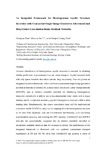Mostrar o rexistro simple do ítem
An integrated inversion framework for heterogeneous aquifer structure identification with single-sample generative adversarial network
| dc.contributor.author | Zhan, Chuanjun | |
| dc.contributor.author | Dai, Zhenxue | |
| dc.contributor.author | Samper, Javier | |
| dc.contributor.author | Yin, Shangxian | |
| dc.contributor.author | Ershadnia, Reza | |
| dc.contributor.author | Zhang, Xiaoying | |
| dc.contributor.author | Wang, Yanwei | |
| dc.contributor.author | Yang, Zhijie | |
| dc.contributor.author | Luan, Xiaoyan | |
| dc.contributor.author | Soltanian, Reza | |
| dc.date.accessioned | 2024-01-30T17:21:04Z | |
| dc.date.issued | 2022 | |
| dc.identifier.citation | Zhan, C., Dai, Z., Samper, J., Yin, S., Ershadnia, R., Zhang, X., ... & Soltanian, M. R. (2022). An integrated inversion framework for heterogeneous aquifer structure identification with single-sample generative adversarial network. Journal of Hydrology, 610, 127844. https://doi.org/10.1016/j.jhydrol.2022.127844 | es_ES |
| dc.identifier.uri | http://hdl.handle.net/2183/35245 | |
| dc.description | Versión aceptada de https://doi.org/10.1016/j.jhydrol.2022.127844 | es_ES |
| dc.description.abstract | [Abstract:] Generating reasonable heterogeneous aquifer structures is essential for understanding the physicochemical processes controlling groundwater flow and solute transport better. The inversion process of aquifer structure identification is usually time-consuming. This study develops an integrated inversion framework, which combines the geological single-sample generative adversarial network (GeoSinGAN), the deep octave convolution dense residual network (DOCRN), and the iterative local updating ensemble smoother (ILUES), named GeoSinGAN-DOCRN-ILUES, for more efficiently generating heterogeneous aquifer structures. The performance of the integrated framework is illustrated by two synthetic contaminant experiments. We show that GeoSinGAN can generate heterogeneous aquifer structures with geostatistical characteristics similar to those of the training sample, while its training time is at least 10 times faster than that of typical approaches (e.g., multi-sample-based GAN). The octave convolution layer and multi-residual connection enable the DOCRN to map the heterogeneity structures to the state variable fields (e.g., hydraulic head, concentration distributions) while reducing the computational cost. The results show that the integrated inversion framework of GeoSinGAN and DOCRN can effectively and reasonably generate the heterogeneous aquifer structures. | es_ES |
| dc.description.sponsorship | This work was funded by the National Key R&D Program of China (No.2018YFC1800904), the National Natural Science Foundation of China [NSFC: 41772253, 41972249], Jilin University through an innovation project awarded to the corresponding author [45119031A035], JLU Science and Technology Innovative Research Team [JLUSTIRT 2019TD-35] and partially supported by the Graduate Innovation Fund of Jilin University awarded to the first author (101832020CX233). Additional funding was provided by the Project (No. QQHR-2016-06) of Groundwater Quality Evaluation in Central City of Tsitsihar, Heilongjiang Province, China. We thank the ILUES and ConSinGAN developers for sharing their codes (https://github.com/cics-nd/cnn-inversion; https://github.com/tohinz/ConSinGAN). The geologic data used to represent permeability map distribution can be found in http://www.trainingimages.org. The authors would finally like to thank the two anonymous reviewers and the Editors for their constructive comments to improve the paper. | es_ES |
| dc.description.sponsorship | China. National Key R&D Program of China; 2018YFC1800904 | es_ES |
| dc.description.sponsorship | China. National Natural Science Foundation of China; 41772253 | es_ES |
| dc.description.sponsorship | China. National Natural Science Foundation of China; 41972249 | es_ES |
| dc.description.sponsorship | China. Jilin University; 45119031A035 | es_ES |
| dc.description.sponsorship | China. JLU Science and Technology Innovative Research Team; JLUSTIRT 2019TD-35 | es_ES |
| dc.description.sponsorship | China. Graduate Innovation Fund of Jilin University; 101832020CX233 | es_ES |
| dc.description.sponsorship | China. Groundwater Quality Evaluation in Central City of Tsitsihar, Heilongjiang Province; QQHR-2016-06 | es_ES |
| dc.language.iso | eng | es_ES |
| dc.publisher | Elsevier | es_ES |
| dc.relation.uri | https://doi.org/10.1016/j.jhydrol.2022.127844 | es_ES |
| dc.rights | Atribución-NoComercial-SinDerivadas 3.0 España | es_ES |
| dc.rights.uri | http://creativecommons.org/licenses/by-nc-nd/3.0/es/ | * |
| dc.subject | Heterogeneous aquifer structure | es_ES |
| dc.subject | Inversion | es_ES |
| dc.subject | Generative adversarial network | es_ES |
| dc.subject | Residual network | es_ES |
| dc.subject | Deep learning | es_ES |
| dc.title | An integrated inversion framework for heterogeneous aquifer structure identification with single-sample generative adversarial network | es_ES |
| dc.type | info:eu-repo/semantics/article | es_ES |
| dc.rights.access | info:eu-repo/semantics/embargoedAccess | es_ES |
| dc.date.embargoEndDate | 2024-04-27 | es_ES |
| dc.date.embargoLift | 2024-04-27 | |
| UDC.journalTitle | Journal of Hydrology | es_ES |
| UDC.volume | 610 | es_ES |
| UDC.startPage | 127844 | es_ES |
| dc.identifier.doi | 10.1016/j.jhydrol.2022.127844 |






